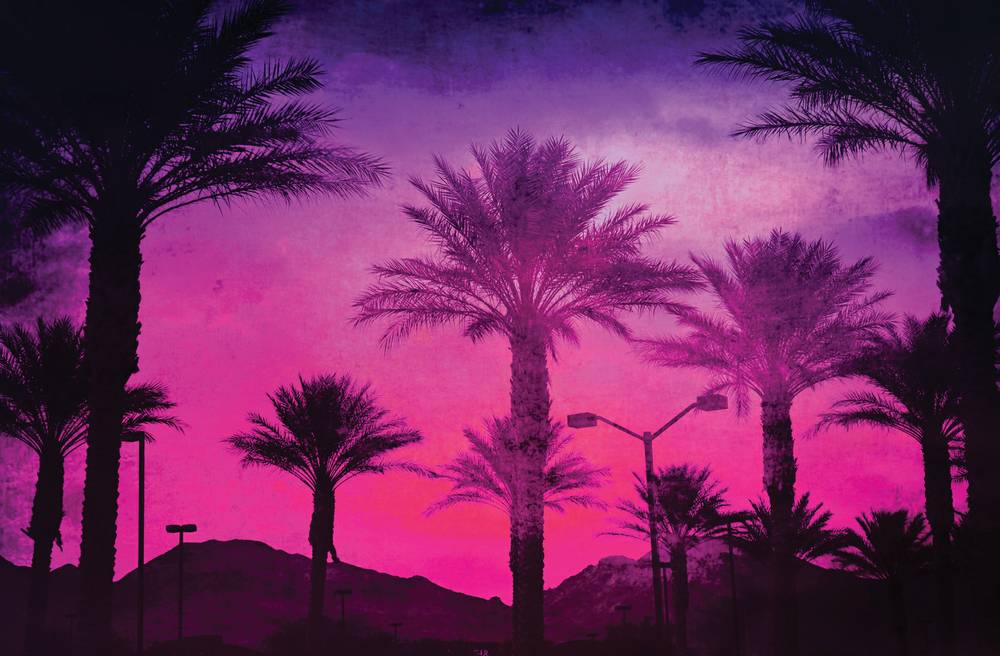It’s a beautiful pink-and-purple evening when we walk out of the Downtown Summerlin movie theater and look toward the city skyline. Strip lights are twinkling, the air is cool, and a row of palm trees is in silhouette.
Palm trees were the symbol of choice here—not hyper-alert yuccas, not gangly chollas, not the scrubby Creosote bushes that grow unassumingly all over this desert—sky-high, carefree, imported palm trees. They’re a symbol of leisure and luxury, of tropical exoticism, of casting off worries and enjoying the moment. Palm trees say, Relax, everything is fabulous.
But tonight they’re stressing me out. Truth be told, they always get my head churning—and right now, they remind me of Indonesia, where one of the world’s largest environmental disasters is taking place: massive slash-and-burn fires aimed at clearing land primarily for palm-oil plantations. The burning rainforests and peatlands are spewing so much toxic pollution that half a million people are sick or displaced, some have died from respiratory illness and six provinces have declared states of emergency. Reductively, the fires are driven by the multinational palm-oil industry, so that land can be reused to grow palms to make oil to sell cookies, cosmetics, soap, soda—commodities galore.
I stop to stare at the tall, simple palms. I know it’s a whole different chapter of the tree’s story here, so I try to shake the buzzkill and absorb the intended lux-life vibe. But something about palm trees belies simple symbolism. Just as something about simple symbolism belies Las Vegas.
* * * * *
Psalm 92:12—The righteous shall flourish like the palm tree. Though not native, palm trees inundate the city. They’re lined up in the median behind the Welcome to Downtown Las Vegas sign, they’re on top of Red Rock Resort, they’re on the Strip. They’re in parking lots and parks and yards. With more than 2,500 species to pick from, they’re in every landscape architect’s repertoire. Some sell for upwards of $15,000, making them a black-market commodity: Thieves in LA dressed in orange work-crew uniforms were caught stealing city palm trees in broad daylight a few years ago.
Palm trees have a long history in human culture: Date palms were present in early Mesopotamian civilizations, providing high-calorie fruit, frond shade and stem fiber for ropes. Palms were a symbol for early Greek and Roman victory; they were laid at Jesus’ feet; they are mentioned in the Quran more than 20 times. They grace the flags of nations and states; they provide medicine and fuel; they’re a landscaper’s easy staple and a marketer’s iconic building block. Tall and lean, short and squatty, fruitful or not, they’ve generally been viewed as life-giving and positive.
And yet they also have a peculiar ability to take life away. In January, a 46-year-old North Las Vegas man died while trimming a 30-foot palm tree. He had climbed up the tree, inside the old fronds at the top, and began trimming. The fronds—which together can weigh hundreds of pounds—collapsed, crushed his chest and suffocated him. He was the second trimmer trapped and killed in a palm tree in North Las Vegas within a month. This happens often enough that some communities have created outreach campaigns to warn workers of the danger, instructing them to cut old fronds from the outside first—but that’s difficult without a crane, and cranes are pricey.
So the tree that symbolizes carefree escapism—a symbol we use prolifically in Las Vegas—can literally trap and kill its caretaker. When I see old palms with heavy, brown fronds—ignored too long in a forgotten neighborhood awaiting stop-gap maintenance, I don’t feel carefree or exotic. I don’t think everything is fabulous.
* * * * *
Triple irony: July, poolside at the Cosmopolitan. As tourists and locals bathed in layers of luxury, a play within a play emerged. A fire broke out and started burning palm trees—fake palm trees, in the desert, by the pool on the 14th floor. A huge plume of dark smoke showed up on social media. Guests fled. Was anyone drinking palm oil in their soda mixer? Wearing palm oil in their cosmetics? Eating palm oil in their chips when the fake palm tree/imitation of a symbol of luxury/overlooked reminder of heinous deforestation in Indonesia caught fire?
Thankfully, few were hurt and no one was killed. It wasn’t an environmental disaster that displaced villagers and suffocated children and demolished a rainforest for shampoo. Instead, the resort swiftly reopened the area and escapism resumed. Fabulously.
Truth is, the palm tree is a beautiful and multifaceted plant. But the reason I like them is in spite of, not because of, their overused connotation of leisure. I see them as fellow witnesses to our folly, dropped into all kinds of chaos, mutually uncomfortable and yet madly resilient.







